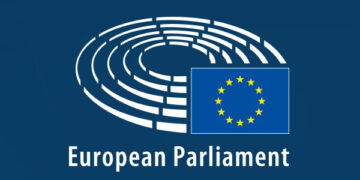The EU’s Anti-Coercion Instrument provides a powerful tool for responding to Donald Trump’s 20% tariff on EU imports. But a coordinated international response with partners like Canada and Japan would have far more weight, argues André Wolf.
US President Donald Trump’s announcement of additional 20% tariffs on EU imports as part of his global tariff package has triggered a strong political reaction in Brussels. The EU appears determined to respond to this new escalation in the trade dispute with direct countermeasures.
The political room for manoeuvre to do so has widened considerably in recent years. In its “Open Strategic Autonomy” trade policy strategy, the EU has legitimised unilateral safeguard measures as a last resort to assert European interests. With the ensuing pieces of legislation, it has created a new framework for the use of such safeguards.
The EU’s Anti-Coercion Instrument
One tool currently at the centre of the debate is the Anti-Coercion Instrument. It was introduced by the EU in 2023 as part of a regulation in response to the attempted political blackmailing of Lithuania by the People’s Republic of China. It is based on an official recognition of economic coercion by an implementing regulation of the European Commission.
According to the regulation, economic coercion occurs when a third country takes or threatens to take a measure affecting trade or investment in order to force the EU or individual member states to take certain political decisions. Where economic coercion is identified, the regulation sets out a step-by-step procedure. It starts with joint consultations with the third country concerned, looking at options such as direct negotiations or recourse to international arbitration to resolve the matter.
If this proves insufficient to end the coercion, the Union moves on to its own unilateral countermeasures from a list annexed to the regulation. This includes a broad catalogue of countermeasures ranging from tariff increases and exclusion from public procurement to restrictions on intellectual property rights protection – even if this implies a violation of the EU’s existing international commitments.
Responding to Trump’s tariffs
In the current situation, EU representatives seem to consider the use of this instrument against the US as a last resort. From a tactical point of view, it is also fundamentally sensible to make the US administration aware of the EU’s own political room for manoeuvre. However, the legal and economic constraints associated with the use of this instrument significantly reduce the credibility of this threat.
Economic coercion according to the definition in the regulation only exists if a third country deliberately attempts to influence a specific law with its economic policy measures or threats. This is not the case with the current measures. In its communication, the US administration has made clear that its objective is to improve the overall competitiveness of its domestic industry and, in the long term, to improve the US trade balance.
The tariff increases are therefore not aimed at withdrawing or introducing specific European legislation but rather represent a call for general economic policy stimulus to strengthen European demand for US goods. This shows a crucial difference from the original reason for the regulation, namely China’s behaviour towards Lithuania. China’s specific aim was to force Lithuania to back down on its Taiwan policy. The measures taken, an informal boycott of Lithuanian goods, go far beyond current US tariff policies.
Reasons for caution
This is not to say that in other cases the US government would not seek to influence specific EU laws through the threat of coercive measures, for instance in the areas of data protection or sustainability reporting. But for the sake of the EU’s credibility, this needs to be demonstrated on a case-by-case basis and should not be confused with the question of a future trade regime.
The temptation for the EU to respond to a seemingly irrational and chaotic US policy with its own disruptive measures is great. But in the end, this would only fuel the Trump administration’s apparent desire to replace rule-based trading with the reign of economic strength. The EU would send a signal to the world that it too has abandoned the idea of multilateral agreement.
Many poorer countries would also feel emboldened to adopt similar defensive measures against EU legislation, for example if the EU intervenes in the design of international supply chains by imposing sustainability requirements. Finally, a purely unilateral defence strategy could also undermine the EU’s plans to reduce trade risks through strategic investment partnerships with third countries. As in the case of US tariffs, EU countermeasures are likely to have indirect negative effects on partner countries through supply chain dependencies.
International cooperation
The EU would therefore be well advised to carefully coordinate its response to the latest tariff escalation internationally. In doing so, it is likely to find a strong willingness to cooperate on the part of economically and politically important partners such as Canada and Japan.
These countries are even more severely affected by Trump’s trade policy and also share many of the EU’s long-term economic visions, such as its commitment to climate neutrality. Establishing a common negotiating position and coordinating countermeasures in the absence of an agreement would significantly increase the EU’s weight. It would also show the US administration the limits of its efforts to divide the West along political lines.
At the same time, the EU should identify new opportunities for mutually beneficial cooperation with the US as a way out of the tariff spiral. In particular, setting a link with Europe’s needs in the course of the green transition is recommendable. For the foreseeable future, the EU will remain heavily dependent on imports of liquefied natural gas (LNG) as a bridge technology to climate neutrality if it does not want to fall back into its old dependence on Russia. Since the 2022 energy crisis, the US has already significantly increased its LNG exports to Europe and invested in new export infrastructure.
The Trump administration also relies heavily on energy exports to improve the US trade balance. In principle, new long-term contracts for LNG supplies to Europe would be in both sides’ interests. They would limit the exposure of EU imports to global market risks, while providing US exporters with a stable basis for refinancing their capacity investments. A current obstacle to the conclusion of such long-term contracts, the uncertainty about the remaining duration of natural gas use in the EU, could be overcome by the parallel conclusion of contracts for resale options within the EU internal market.
There is also a lot of untapped potential for cooperation on strategic commodities. Metals such as rare earths or lithium will become even more politically important in the future because of their relevance to many future technologies on both sides of the Atlantic, even in the face of fundamentally different approaches to climate change.
Joint exploration of raw materials and co-financing of investment projects could bring the US and Europe closer together through their shared interest in reducing existing dependencies on China. To this end, the Minerals Security Partnership created to secure access to raw materials should be brought to life.
Note: This article gives the views of the author, not the position of EUROPP – European Politics and Policy or the London School of Economics. Featured image credit: Joshua Sukoff / Shutterstock.com






































Discussion about this post